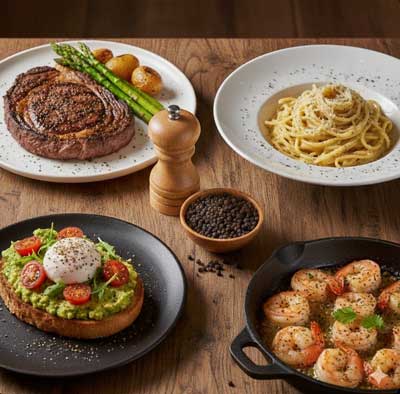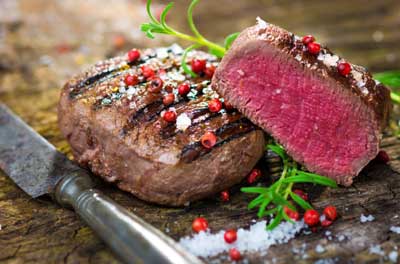Peppercorns are a kitchen staple, yet many home cooks and even experienced chefs don’t realise just how versatile this humble spice can be. Beyond adding heat and flavour, the colour and type of peppercorn you choose can enhance the aroma, texture, and balance of a dish. From black and white to red and green, each variety has unique characteristics that make it ideal for certain recipes and culinary pairing tips for pepper.
Black peppercorns: pair with Bold, Spicy, and Versatile

Black pepper is most common and widely used , celebrated for its warm, pungent heat and complex aroma. Its bold flavour makes it perfect for meats such as steak, lamb, or beef stew, whether crushed or freshly ground in a marinade or rub. It also complements roasted or sautéed vegetables like carrots, zucchini, or mushrooms, adding depth and warmth. In soups and stews, black pepper enhances both meat and vegetable flavours, while freshly ground pepper can elevate eggs or creamy cheeses without overpowering them. Using black pepper early in cooking helps release its full aroma, while grinding it fresh over salads or as a finishing touch delivers a punchy burst of flavour.
White peppercorns: Subtle, Earthy, and Elegant
White pepper offers a milder, cleaner heat with a slightly earthy, fermented undertone. Its refined taste and pale colour make it ideal for dishes where black specks might look out of place, such as cream sauces, béchamel, or Alfredo. It also works beautifully in mashed potatoes and cream-based soups like potato, cauliflower, or mushroom, adding warmth without disrupting the smooth appearance. In Chinese and Southeast Asian cuisine, the white spice is used in stir-fries and soups to add a subtle kick that doesn’t overpower delicate ingredients. To preserve its aroma, it is best added toward the end of cooking rather than exposed to long heat.
Red peppercorns: Fruity, Sweet, and Exotic

Red peppercorns are harvested fully ripe, producing a fruity, slightly sweet heat that stands out in both taste and appearance. They are particularly effective with seafood, complementing shellfish, salmon, or mild white fish while adding gentle warmth. Red pepper also shine in sauces and vinaigrettes, where lightly crushing them releases their fruity aroma, and in seasoning blends with herbs like rosemary, thyme, or basil for roasted meats or vegetable medleys. They add visual interest and subtle heat to cheese and charcuterie boards as well. Because of their natural sweetness, red peppercorns pair beautifully with dishes incorporating fruit or honey, such as glazed duck or roasted root vegetables with orange.
Green peppercorns: Pair with Fresh, Fruity, and Mild Flavours
Green peppercorns are harvested while unripe and preserved by freeze-drying, air-drying, or pickling to maintain their fresh, herbal flavour. Milder and fruitier than black or red peppercorns, they are excellent for dishes that require a gentle pepper note. Classic French preparations like steak au poivre vert or chicken in green pepper cream sauce highlight their fresh heat, while they also enhance subtle proteins such as chicken, turkey, shrimp, or cod. Pickled green pepper add crunch and mild heat to sauces, chutneys, or relishes, and lightly sautéed or roasted vegetables gain a fresh, slightly fruity kick. Using whole green peppercorns in braises or stews allows their mild heat to infuse slowly, creating depth without the sharp pungency of black pepper.
Mixing Peppercorns for Complexity
Many chefs and home cooks like to combine different peppercorns to create layered flavour experiences. A blend of black, white, and green peppercorns produces a balance of heat, aroma, and freshness, while a mix of red and black can enrich roasted vegetables or meat rubs with fruity warmth and pungency. By experimenting with different combinations, you can tailor the heat, aroma, and visual appeal to the specific dish, making this humble spice remarkably versatile.
Tips for Using in the Kitchen

To get the most from your peppercorns, grind them fresh whenever possible, as whole pepper retains aroma and essential oils far longer than pre-ground varieties. Consider both the colour and intensity of the pepper when selecting the right type for your recipe: use black for bold, hearty dishes; white for creamy or light-coloured recipes; red for fruity or elegant dishes; and green for subtle, fresh flavours. Peppercorns also pair beautifully with other spices and herbs such as garlic, thyme, rosemary, turmeric, or ginger, helping to elevate the overall taste profile of your dishes.
Peppercorns are more than just a seasoning; they are a tool for creating depth, contrast, and personality in every meal. Understanding the differences between black, white, red, and green peppercorns allows you to elevate flavours, add visual interest, and make every dish uniquely memorable.